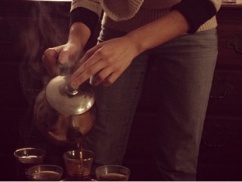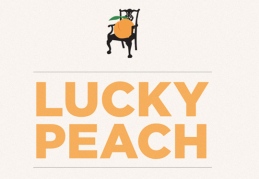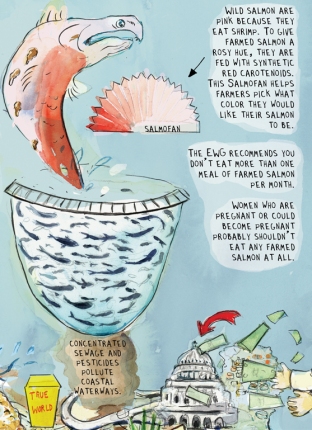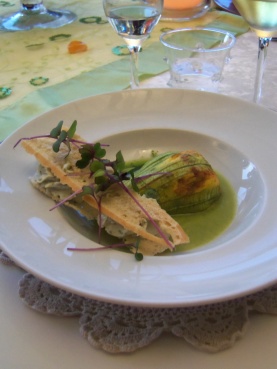 Tonight I had a long conversation with Lois Ellen Frank, a half-Kiowa native and half-Sephardi Jewish chef who grew up in Long Island and is now based in Santa Fe. I was so inspired by her passion and her praxis. She is literally decolonizing her body and her family and healing trauma in native communities through growing and preparing food and teaching how to do it!
Tonight I had a long conversation with Lois Ellen Frank, a half-Kiowa native and half-Sephardi Jewish chef who grew up in Long Island and is now based in Santa Fe. I was so inspired by her passion and her praxis. She is literally decolonizing her body and her family and healing trauma in native communities through growing and preparing food and teaching how to do it!

In a slightly different vein, last night I watched “Julie and Julia.” And although Julia Child and the woman from Queens who blogged as she cooked her way through Julia’s cookbook were not doing much to connect with communities or confront systems, I got almost as energized and happy watching them as I did talking with Lois tonight. Because when it comes down to it, when I listen to or am around other folks for whom food is a liberating/pleasing/exciting element of their lives, a force that turns them on and takes them places…I don’t feel like such a freak! I feel like there are others like me!
It’s interesting because Julia Child’s passion for quality food and commitment to making it accessible to women “without cooks” and her genuine enthusiasm and appreciation of the delights of picking out a vegetable or a piece of meat or a loaf of bread at the market in Paris, are all not radical tendencies per se, but she lived in a committed, unabashed, joyful and sensual relationship with food, which was not a small task for a woman in the society she lived in. And becoming the professional and knowledgeable cook that she did was crossing, as Lois said tonight, “culinary gender lines.” Lois shared with me how she does not get listened to in the kitchen by the team of cooks sometimes until Chef Walter, her partner in crime, repeats her instructions. And then, crossing the culinary gender line from a different direction, Walter, a Dine (Navajo) man who comes from a very traditional family, was scorned for wanting to cook.
Rejecting government definitions of healthy eating is also an act of rebellion that Julia Child and Lois/Walter have all engaged in. Julia’s praise for butter and her excessive use of it certainly defied all the formulas for eating that were provided at that time…and while it’s probably not healthy to eat the recipes that she shared all the time, the wisdom of the French way of eating is that you eat the freshest and highest quality local ingredients, you eat smaller amounts, you eat slowly, and you have a little wine. The problem is that when French cuisine gets taken out of the broader culture and planted within U.S. society, you keep the butter and lose the quality of ingredients and philosophy which actually lead to a different digestion process.
And this is exactly what Lois talked to me about tonight.
She is helping build a movement to be healthy and specifically to combat diabetes in native communities by returning to ancestral diets.
Native ancestral diets necessitate the use of foods that have to be worked with and prepared by hand and can’t be mass produced. So when we eat those foods and buy them from the small communities that produce them, it is a win-win for everyone—you keep these traditions alive and you get healthy.
We all know that there are differences in which foods different groups of people around the world can process. However, the government developed the food pyramid in a way that does not take into account the different nutritional needs of different communities (i.e., natives tend to be lactose intolerant but dairy is one of the main parts of the pyramid).
So Lois and Walter have developed an alternative to the Food Pyramid. They call it the “Power Plate.” There are four elements of the Power Plate: legumes, grains, fruits, and veggies. (According to Lois, native foods used to be 90% plant-based.)
Lois gave her own tribe as an example of how the digestion systems and food ways of a people can be disrupted and cause huge societal damage. The Kiowa were the original peoples of the areas around what is now Yellowstone National Park, extending to Iowa. They were displaced along with about 50 other tribes and forcibly moved to Oklahoma, where the government gave them seeds and told them to farm. However, they were historically hunter-gatherers, so there was a starvation period during which government rations began (lard, sugar, wheat, etc). Now Lois and others are working to “decolonize our bodies with our diets” as an essential element of healing native communities from trauma and oppression.
Another insightful and impactful element of Lois’s work is her definition of “Native Cuisine.” She understands that no culture is “pure” and that communities have been influenced by each other’s foods forever…that there has always been “fusion cooking” as a result of cultures interacting. (She points out how archaeologists have found ancient cacao remains in North America, demonstrating how extensive the trade routes of pre-contact natives were: “Our brothers and sisters from down south were coming up here and trading cacao!”)
Lois gives the example of sheep amongst the Navajo. She says that if you tell a Navajo child that sheep aren’t “native” (because they originally were introduced by the Spanish), the child will cry. And the truth is, they ARE native…just beginning in a certain way at a certain point (just like everything else). So Lois and her partners have developed the term “first contact food” to refer to these foods that were almost immediately exchanged (and it truly went both ways—natives dramatically influenced European cuisine, changing it forever. The tomato in Italy is one example of this).
Although it seems totally silly to assert this connection too strongly, there is a parallel between Julia Child’s commitment to making French cooking accessible to housewives without servants/cooks and Lois’s commitment to making organic, sustainably produced foods possible in low income households. One way her team is doing this is by creating recipes and teaching people how to cook these recipes that they have calculated to be as low as $1.27 per person for a meal. They’ve developed a recipe they call “No Fry Fry Bread”—made out of lentils—and it costs 27 cents a serving. (They have developed language referring to fry bread or Indian tacos as being “sometimes” food—so that while they are not being negative about these foods that are comfortable and familiar, they are facilitating people moving away from eating too much of these foods, which are the result of government food rations.)
Lois’s personal system is dry farming; she grows as much food as she can living in the desert. And she does things like arranging to buy “seconds” from the farmers’ market: she buys the bruised tomatoes that the farmers can’t sell at market, makes and cans tomato sauce, and barters it for salmon and berries from her friends in the Northwest. Cool! I’m so inspired, and wondering what bartering systems amongst my friends I can set up. My sister Tehila and I had floated the idea of a “market day” once a month where we each bring prepared foods and barter them with each other (pickles, bread, etc). Maybe we can…?
So, although I am so charmed by Meryl Streep’s portrayal of Julia Child as fearlessly in love with eating, as well as eternally positive (I love anyone who geeks out about hollandaise sauce as much as she does in that movie)…the truth is that watching Julie and Julia got me all happy and then Lois and her organization, Red Mesa, took me home.
Check out what Lois and Chef Walter do more extensively at their website.
Lois, as well as some other creative and committed women working on different aspects of food production and preparation, is featured in this book: Farmer Jane: Women Changing the Way We Eat.















